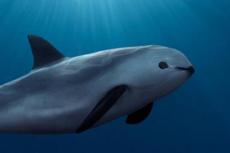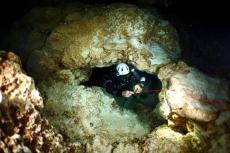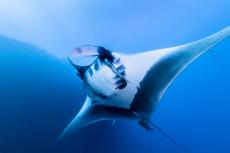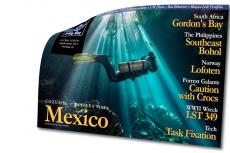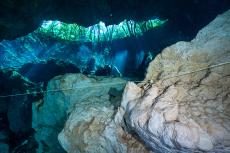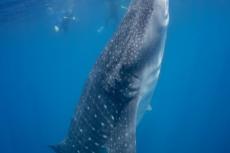Cages or no cages? ... Whose business is it anyway?
Are divers tempting fate with Guadalupe Island Great White sharks? Tour operators engage in a war of words over shark diving practices.
Weighing in at up to 3,000 pounds and attaining lengths of 18 feet, Great White sharks are among the ocean’s most feared yet revered inhabitants. Having a face-to-face encounter with the ocean’s apex predator is a bona-fide adrenaline rush, with divers worldwide shelling out mega bucks and travelling great distances for the privilege.
Boasting pristine blue water with 100-foot visibility, Guadalupe Island situated west of Baja California, Mexico, is one of the world’s premier Great White destinations.
In a bid to promise visitors the ultimate shark experience, Guadalupe outfitters have introduced cage diving to the area. The stakes are high and the competition fierce, with six outfitters vying for the attention of well-moneyed tourists. “It is an unforgettable rush when a Great White looks at you from 50 feet away and then swims over for a very close look,” said Daniel Dayneswood, who works for the British Columbia-based Nautilus Explorer.
However, the evolution beyond the traditional stern-attached surface cages has been swift. Divers in these submersible cages can enjoy the company of Great White sharks from behind steel bars or stand atop a deck with experienced dive masters for an open-water experience. “It’s an arm’s race, and it’s the worst example of one that I’ve ever seen,” said Patric Douglas, who runs Shark Divers, a shark-related tourism, filming and consulting business.
The battle commenced when Lawrence Groth of Shark Diving International started submerging cages to depths of 50 feet, so he wouldn’t have to rely on “chumming” them to the surface—a practice that is now illegal, but still practised by some. In addition to constructing a submersible “cinema cage” allowing film crews unobstructed views, Groth’s latest invention is a horizontal two-person cage with the client laying in front with the camera and Groth in back driving with a joystick.
Ultimate encounters
Renowned photographer, Amos Nachoum, has raised the bar to what some might consider the ultimate level. Through his company, Big Animal Expeditions, Nachoum offers trips allowing divers the opportunity to swim freely among the sharks outside the cage. The privilege doesn’t come cheap, with a US$5,900 price tag for a week-long trip.
Running only one trip annually with a maximum of ten people, Nachoum maintains all guests have extensive scuba experience and must bring lawyer-signed and notarized documents stating that they are aware of the risk of death and serious injury. Only one diver is allowed to venture outside the cage at a time, with a second dive master swimming behind the customer with a stick to push the shark away if it gets too close.
The enterprise has sparked a war of words with some of the other operators. ”He’s new to the whole thing,” said Groth, a pioneer at Guadalupe who himself has been referred to as a “cowboy” using questionable tactics. “He has an inexperienced boat crew, and he’s doing this stupid stuff with anyone who will pay him the money,” he recently told GrindTV.com
Nachoum counters that he has made a business and a living out of “taking and managing risks” for over 30 years, and that he has an immaculate safety record.
“The risk I am taking by diving without a cage comes not from the shark. It is from the public opinion which is not based on fact or experience, just on panic and scare tactics.”
“I dive every dive with my clients and take only one at a time out of the cage. I am escorted at all times by a safety diver, and I do not chum or bait the water,“ said Nachoum.
“The sharks come to Guadaloupe on their own accord to hunt young Elephant seals and chumming and baiting just irritates the sharks. That is why they bang against the cage with open jaws and teeth protruded,” said Nachoum.
“Seeing the shark as entertainment rather than respecting and understanding them is only making the mistake from the Jaws movies all over again—it never seems to end. These movies were seen by millions of people, but the sharks do not know what we expect them to do when we cross the line and venture underwater to see them. That is why operators need to harass and aggravate the shark to show teeth. That is not environmentally correct at all and against any reason and moral values,” said Nachoum.
There are more accidents of divers inside the cages versus out of the cage. As a matter of fact, there is no record of any accident or attack by a Great White on any sport or filming team while diving without cages.
Nachoum also points out that it is also a matter of logistics: “While they [the other operators —ed.] are operating full boats servicing anywhere from 18-24 guests, I only conduct one or two trips with a maximum of ten guests. Of these, only five are screened and allowed to go cageless, and only one at a time.
“I am sure that when it comes to movie and TV projects, they will and do go out of the cages, too. But they are not able to offer that same thing for their regular clientele. It is simply down to the difference between mass production and handmade products,” said Nachoum.
Freaking out
Mike Lever, owner of the Nautilus Explorer, which goes to Guadaloupe, told us that diving without cages like Nachoum does is not permitted according to the local regulations. But he is also concerned that Nachoum’s operation is an accident waiting to happen.
“What concerns me is that someone outside the cage gets freaked out by a shark, and it’s easy to get freaked out by a shark— I’ve been freaked out by them,” he said. “If that person bails to the surface, what kind of reflex are they going to trigger in that animal? And then that person is on the surface thrashing, and then what happens?” “Yes, I am aware of the prophecy of ‘what if’—I do everything humanly to avoid it and withdraw when there are more than two sharks around us.”
Nachoum said other operators—who will remain unnamed—are in violation of regulations by using whole tuna attached to ropes to lure sharks to surface cages and inspire them to open their mouths for camera-toting passengers. The crews yank the tuna away before the sharks can snatch them and this, Nachoum says, “makes the sharks crazy.”
However, what’s legal and illegal is largely moot because Guadalupe is 160 miles off the Baja California coast and enforcement of any rules is difficult. Mostly it’s up to the operators to watch each other, and they do so with great suspicion. One thing they all agree on is that if a fatality occurs, Mexico might immediately shut down all operations. In turn, that would open the island to poaching and shark numbers would be decimated. In the end, it’s in everyone’s best interest to work together, keeping both sharks (and customers) alive. ■








